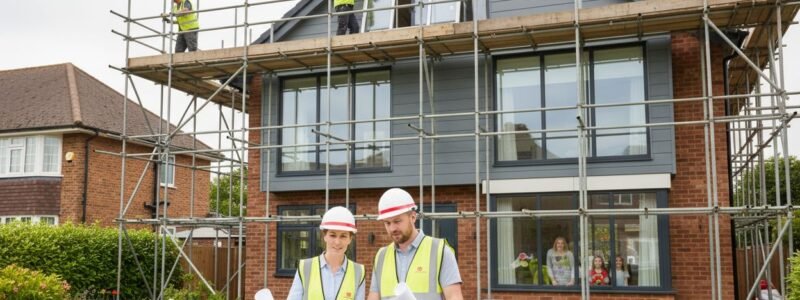More than 80 percent of UK homeowners who extend their property face strict building regulations that affect every stage of their project. From safety to energy efficiency, these rules are not just legal hurdles but essential protections for everyone involved. Understanding the main principles of building regulations can help you avoid costly mistakes and set your extension up for long-term success while keeping your property and those around it safe.
Table of Contents
- Building Regulations: Definition And Core Principles
- Extension Types And Regulatory Differences
- UK Legal Standards And Approval Process
- Key Compliance Steps For Homeowners
- Financial Implications And Common Mistakes
Key Takeaways
| Point | Details |
|---|---|
| Building Regulations Importance | Compliance with building regulations is essential for ensuring safety, health, and environmental standards in construction projects. |
| Extension Types Overview | Different home extension types have varying regulatory requirements, necessitating thorough understanding from homeowners. |
| Approval Process Steps | Homeowners should follow a structured process including consultation, documentation submission, and inspections to achieve compliance. |
| Financial Considerations | Failure to account for compliance costs and potential penalties can lead to significant budget overruns in extension projects. |
Building Regulations: Definition And Core Principles
Building regulations represent a comprehensive legal framework designed to ensure construction projects meet critical safety, health, and environmental standards. According to Gov.uk, these regulations specifically cover the construction and extension of buildings, establishing mandatory compliance requirements for most building work throughout the United Kingdom.
At their core, these regulations serve multiple essential purposes. Building standards protect the fundamental welfare of occupants by mandating specific construction practices that mitigate risks. Key areas of focus include structural integrity, fire safety, thermal efficiency, accessibility, and environmental sustainability. Commons Library research highlights that these regulations aim to safeguard the health and welfare of individuals in and around constructed spaces.
The Building Regulations 2010 outline precise technical requirements that builders and property owners must follow during renovations or extensions. These standards are not merely bureaucratic checkboxes but critical protective measures that ensure:
- Structural stability and safety of buildings
- Protection against fire hazards
- Adequate ventilation and energy efficiency
- Accessibility for individuals with disabilities
- Conservation of water and sustainable resource usage
For homeowners considering an extension, understanding these regulations isn’t optional – it’s a legal requirement. Non-compliance can result in significant financial penalties, potential demolition orders, and complications when selling your property. Understanding the House Extension Approval Process provides additional insights into navigating these complex requirements effectively.
Extension Types And Regulatory Differences
Home extensions come in various forms, each with unique building regulation requirements. Gov.uk confirms that building regulations approval is essential for different extension types, with specific requirements varying based on size, purpose, and structural complexity.
Extension categories demand nuanced regulatory approaches. According to HOA, different home improvement projects require distinct regulatory considerations. Here’s a breakdown of common extension types and their regulatory landscapes:
Here’s a comparison of typical extension types and their building regulation requirements:
| Extension Type | Key Regulation Requirements | Notable Considerations |
|---|---|---|
| Single-Storey | Full approval Thermal efficiency | Detailed plans required |
| Double-Storey | Structural assessment Fire safety | Greater complexity Load-bearing checks |
| Loft Conversion | Structural reinforcement | Compliance with fire safety |
| Garage Conversion | Insulation Electrical compliance | Garage use change Moisture control |
| Conservatory | Partial exemptions Size limits | Dependent on attachment to house |
 |
|
Single-Storey Extensions
- Typically require full building regulation approval
- Must meet thermal efficiency and structural stability standards
- Detailed drawings and plans are mandatory
Double-Storey Extensions
- More complex regulatory requirements
- Comprehensive structural assessments needed
- Additional fire safety and load-bearing considerations
Specific Extension Types
- Loft Conversions: Require specific structural reinforcement checks
- Garage Conversions: Need electrical and insulation compliance verification
- Conservatories: May have partial regulation exemptions depending on size and connection to main property
Navigating these regulations can be complex. Homeowners should always consult local authorities and potentially engage professional architectural services to ensure full compliance. Understanding the Home Extension Planning Checklist provides an excellent resource for initial guidance through this intricate process.
UK Legal Standards And Approval Process
In the United Kingdom, navigating the legal landscape of home extensions requires a comprehensive understanding of two distinct but interconnected processes. Gov.uk clarifies that building regulations approval is fundamentally different from planning permission, with most construction work mandated to comply with the Building Regulations 2010, which establish rigorous standards for design and construction.
The legal framework for home extensions has evolved significantly in recent years. Commons Library research highlights the Building Safety Act 2022, which introduced enhanced rules for construction and refurbishment, particularly focusing on safety standards in residential developments. This legislation represents a critical shift towards more stringent oversight and protection for homeowners.
The approval process typically involves several key stages:
- Initial Consultation
- Discuss proposed extension with local building control department
- Prepare detailed architectural plans
- Assess potential regulatory requirements
- Documentation Submission
- Submit comprehensive building regulation application
- Provide structural drawings
- Include detailed specifications of materials and construction methods
- Technical Assessment
- Building control officers review submitted documentation
- Evaluate compliance with safety, structural, and environmental standards
- Request modifications if necessary
For homeowners navigating this complex process, professional guidance can be invaluable. Understanding the Planning Permission Requirements List offers additional insights into the intricate legal requirements surrounding home extensions.
Key Compliance Steps For Homeowners
Complying with building regulations is a critical responsibility for homeowners planning an extension. Gov.uk emphasizes that checking whether your project requires building regulations approval is the essential first step before commencing any construction work. This preliminary assessment can save significant time, money, and potential legal complications.
The compliance journey involves multiple strategic steps. According to HOA, homeowners must submit detailed plans to their local authority or an approved inspector and arrange for necessary inspections throughout the construction process. This ensures that every stage of the extension meets the required safety and structural standards.
Key compliance steps include:
- Pre-Construction Planning
- Conduct thorough site assessment
- Develop comprehensive architectural plans
- Verify potential regulatory requirements
- Budget for potential compliance modifications
- Documentation Preparation
- Compile detailed technical drawings
- Prepare material specifications
- Calculate thermal efficiency ratings
- Draft structural engineering reports
- Regulatory Submission
- Submit full application to local building control
- Pay required application fees
- Await initial review and feedback
- Address any requested modifications
- Inspection Stages
- Schedule mandatory site inspections
- Permit building control access at critical construction phases
- Maintain transparent communication
- Keep comprehensive project documentation

For homeowners seeking additional guidance through this intricate process, Understanding the Home Extension Consultation Process offers valuable insights into navigating regulatory requirements effectively.
Financial Implications And Common Mistakes
Building regulation compliance is not just about meeting legal requirements – it’s also a significant financial consideration for homeowners. HOA reveals that application fees can range from £100 for plan submissions to £200–£400 for inspections, with potential additional costs for non-compliance that can dramatically impact your project’s budget.
The financial landscape of home extensions involves multiple hidden expenses and potential pitfalls. Building Control Plans warns that homeowners frequently underestimate project timelines and overlook critical approval requirements, which can lead to substantial unexpected expenses.
Common Financial Mistakes to Avoid:
- Budget Underestimation
- Failing to include regulatory compliance costs
- Overlooking potential modification expenses
- Not budgeting for professional consultation fees
- Ignoring potential penalties for non-compliance
- Hidden Cost Triggers
- Unexpected structural reinforcement requirements
- Additional architectural modifications
- Extended project timelines
- Professional inspection and resubmission fees
- Compliance Cost Breakdown
- Initial application fees
- Architectural and engineering consultations
- Mandatory site inspections
- Potential retroactive modification expenses
- Legal compliance documentation costs
Understanding these financial nuances is crucial for a successful extension project. Understanding the Planning Permission Requirements List can provide further insights into navigating these complex financial considerations effectively.
Expert Support to Navigate Building Regulations with Confidence
Understanding and complying with building regulations can feel overwhelming, especially when balancing complex rules on structural safety, fire protection, and energy efficiency. If you worry about costly delays or risking non-compliance penalties for your home extension, you are not alone. Many homeowners find the detailed requirements and approval processes daunting, from preparing precise technical drawings to passing multiple inspections.
At Reltic Extend, we specialise in guiding you through each stage with clarity and expertise. Explore our Planning & Permissions for Home Extensions | Reltic Extend page to discover how we simplify this journey, ensuring your project meets all legal standards smoothly. Whether you are considering a single-storey or double-storey extension, our experience in designing and managing bespoke extensions means your investment is protected with quality and compliance at its core.
Don’t let regulatory challenges delay your dream home improvement. Take control today by visiting our Types of Home Extensions & Ideas | Reltic Extend for inspiration and practical advice. Then reach out directly through our contact page to start your personalised consultation. You deserve a home extension that is safe, stylish, and stress-free—act now to make your vision a reality.
Frequently Asked Questions
What are building regulations for extensions?
Building regulations for extensions are a set of legal requirements that ensure construction projects meet safety, health, and environmental standards. They cover various aspects such as structural integrity, fire safety, thermal efficiency, and accessibility.
Do I need building regulations approval for a single-storey extension?
Yes, a single-storey extension requires full building regulations approval. It must meet specific standards related to thermal efficiency and structural safety, with detailed plans submitted for review.
How do building regulations differ for loft conversions compared to garage conversions?
Loft conversions typically require structural reinforcement checks and must comply with fire safety regulations, while garage conversions need to verify electrical compliance and insulation. Each type has distinct requirements based on its structure and usage.
What steps are involved in the building regulations approval process for home extensions?
The approval process generally involves initial consultations with local authorities, submitting detailed documentation and architectural plans, undergoing technical assessments, and scheduling mandatory site inspections throughout the construction phase.





